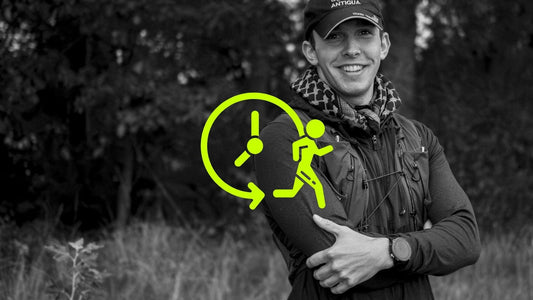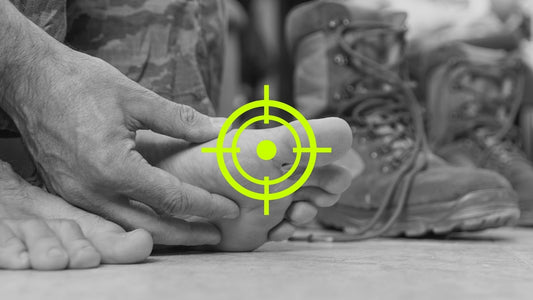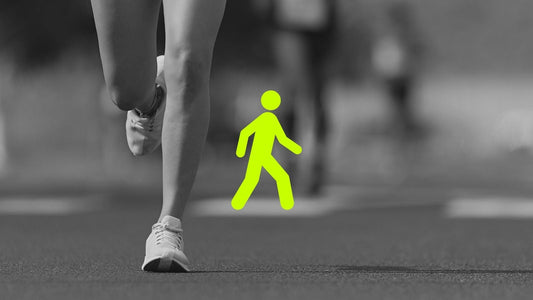UK weather can be unpredictable, so if you live here and want to keep running you have to be prepared to get up and go whether rain or shine. But what about snow? Many of us will hear the safety officer in our brain already saying “No way! Snow equals slipping, and slipping equals injury”, but that isn’t necessarily true. Some of the funnest runs I have ever had have been out in the snow, up high on some mountain crest - a place I feel truly alive and free. So this post is there to help you do it properly, whether you're in a snowy city or up high on the winter fells.
Here, we’re answering all the questions you have about running in snow, including whether or not it’s actually safe to do it, if it’s harder than regular running, how it could impact your training, how to do it safely, what you should wear, and more.
At The Feets, our aim is to keep your feet healthy and happy, so of course it wouldn’t be one of our blogs if we didn’t share some pre- and post-run foot care tips for when your toes are extra cold in the snow. Running in winter can be a great experience, so let’s dive in to see how to do it properly…

Should I even run in the snow?!
Contrary to what your cautious grandmother might tell you, you can run in the snow if you do it safely and prepare ahead of time. In fact, you could get a number of benefits from doing this, including the mental toughness that results from running in adverse weather, which will serve you well on race day (if you’re training for one), or in life more generally.
However, if you wake up to snow, don’t just shove on your trainers and head out in it. Colder temperatures, slippery surfaces and hidden hazards beneath the snow are all considerations for your snowy run, so you need to prepare ahead of time by wearing the correct clothing and shoes, prepping your feet for the cold and wet weather, and sticking to a safe route.
OK, I’m going for it. How do I run in the snow safely?
As someone who has run in the snow many times (I don’t let Jack Frost keep me from my training), here are some of my top tips for running in the snow:
- Spend more time warming up ahead of your run so your muscles are ready to take on the colder temperatures
- Wear appropriate shoes and clothes for the snow (more on this below)
- Choose off-road trails as there’s less chance of encountering icy patches, but avoid big open fields where there may be hidden dips and holes that could cause you to roll your ankle
- Aim for running on fresh snow that hasn’t been compacted, as this will give you more traction so there’s less likelihood of slipping
- Shorten your stride to avoid slipping, and slow right down – remember it is far better to do an easy, slow run than to keep your usual pace and end up injured due to a fall
- On that note, aim for time instead of distance as your run will be naturally slower
- Walk (or slowly run) a loop to start with, being cautious of what might be under the snow. Once you feel confident there is no ice or other dangers you can run the same loop as many times as you like with a little more speed
- Run around lunchtime if you can as this is when you are less likely to encounter ice (which tends to form in the early morning and evening)
- Forget about the stats for a while, and use snow days as a chance to add variety to your training by experimenting with different types of running
|
Important: Although we encourage you to get outside in the snow if you can and continue your running training safely, it would be silly not to acknowledge that running in snow does mean there is more chance of slipping and falling, and ending up with a serious injury, so always do so with caution – don’t be a hero, slow your pace and be careful! Also, if you suffer from the likes of asthma, Raynaud’s Disease, diabetes, arthritis, Chronic Obstructive Pulmonary Disease (COPD), Multiple Sclerosis (MS), or another potentially serious health condition, consult your doctor before spending time in cold temperatures. |
Is it harder to run in snow?
It can feel more difficult to run in the snow because – depending on the depth of snow – you may be using different muscles in your feet and calves to stabilise yourself. For this reason, you could be surprised to find that you feel a little sore the day after running in the snow, because your body won’t be used to using these muscles to help you stay balanced.
Plus, snow adds resistance in general due to the uneven terrain, so it can feel like more of a challenge and potentially get your heart rate going more than running on a dry surface would. It also requires more mental focus to dodge hidden objects and maintain pace.
How can snow impact your training regime?
Snow will alter your training regime, but it doesn’t have to be a negative thing. While you may not be able to go out and run at your usual pace, you can experiment more with things like your stride length and cadence, and challenge yourself in new ways. By thinking of it more like a cross-training session to strengthen other muscles, you can take a break from the increasing mileage and make the most of the enhanced cardiovascular endurance.
If your running is linked to a weight loss goal, it’s worth knowing that studies suggest exercising in snow could actually burn more calories. This is thought to be due to the movement of shivering in the cold weather, and your body tapping into burning brown fat in order to maintain core temperature (known as thermogenesis). A winning combination for burning calories.
Of course, many days or weeks of snow will impact your training, so if you want to continue building your speed or distance, it may be best to continue with treadmill workouts in the interim so you don’t fall behind with your goals.
What about running on ice?
The trickiest part of running in snow is that you are more likely to encounter ice, and it can be difficult to notice it mid-run. Unlike running in snow, running on ice should be a big no-no unless you have shoes specifically designed for this (yes, these do exist!).
Running on ice without appropriate footwear massively increases your chances of slipping, falling, and ending up with an injury. Your shoes need to have excellent traction, with ice grips or spikes to enhance stability, and you MUST shorten your stride and avoid sudden movements to maintain balance.
Unless you want to get the experience for a race that is likely to have you running on ice, then it may not be worth it for you. If there are occasional spots of ice on your running route it’s best to avoid these or walk over them instead. Or, if most of your route is covered in ice, I would opt for an indoor treadmill training session instead to reduce your chance of injury (remember ice is VERY HARD!!!). If you don’t have access to a treadmill, consider travelling by car or walking to an area that has been cleared of ice, such as a park with paths that have been treated with grit.
What shoes and accessories do I need for running on snow?
You should definitely consider your footwear and clothing before running in the snow, as the low temperatures and increased risk of slipping mean your usual garments probably won’t cut it.
Shoes and Socks
I’m sure it isn’t news to you, but snow is cold, and since your feet may be coming into contact with snow the most, it’s important to ensure you have proper waterproof, winter-proof running shoes with insulation for warmth, and traction underfoot. If snow is soft and fresh, a pair of trail running shoes will do the trick, or fell running shoes are helpful in deeper snow as they usually have a more sticky rubber on the sole. Some good trail shoes you may want to look into include Altra Lone Peak (Timp or Mont Blanc), Saucony Peregrine, Inov-8 Parkclaw (Trailfly or Roclite), and Salomon Speedcross.
If you plan to run on firmly packed snow or ice, you should consider a pair of running shoes with spikes for added traction, or shoe covers that will add spikes to the bottom of your shoes to keep you steady on your feet and avoid slips.
Moisture-wicking, insulated socks are also a must when running in snow, as they will keep your feet warm and dry. If you plan on running in snow a lot, you could also invest in a pair of gaiters to avoid snow getting into your shoes and making your feet wet.
Clothing
It’s all about layers in colder temperatures. Here’s what I would suggest:
- Full-length (potentially fleece-lined) leggings to keep your legs warm and provide additional cushioning in case of falls. Padded cycling shorts under your leggings could also offer this cushioning.
- A thermal, long-sleeved, moisture-wicking running top with an additional layer over this that can be removed as your temperature starts to rise during your run.
- A light, breathable, waterproof running jacket as your top layer in case it is actively snowing, and to provide additional protection from wind chill.
Accessories
You should also consider wearing gloves during your run to keep your hands warm, and a hat to keep your head and ears nice and toasty. If you are sensitive to the cold air, or it is particularly cold or windy, a face cover (such as a Buff) can keep your nose and mouth protected by helping to warm up and moisten the air before it reaches your lungs.
Other things to consider wearing on your snowy run include sunglasses to shield your eyes from snow glare, a headlamp if you’re doing early morning/late night runs without sunlight, and reflective gear to ensure you are visible to cars while running on the road.
What should I do for my feet before running in the snow?
We love to make sure your feet are top-of-mind when preparing for a run, so here are some top tips for looking after your feet before heading out to train:
- As well as moisture-wicking socks, you should also consider wearing an additional thermal sock over this to keep your feet warm and avoid frostbite on long runs
- Consider using an antiperspirant on your feet to avoid excessive sweating while running, as sweat can feel even more uncomfortable if it dries in cold temperatures
- Keep your toenails trimmed when running, as colder temperatures could mean your feet feel numb, and you won’t be aware of any pain, discomfort or rubbing
What should I do for my feet after running in the snow?
Taking care of your feet post-run is also important. Here’s how:
- Remove wet shoes and socks straight away, and dry your feet with a towel to avoid issues like Athlete’s Foot (check our Athlete’s foot powder for help)
- Look at your feet for any signs of frostbite or blisters you may not have felt while running in the cold, and address any that have developed
- Stuff your shoes with newspaper or something else to absorb moisture. This will not only keep their shape, but will dry them faster so you aren’t putting on damp shoes on your next run (I always chuck mine in the airing cupboard!)
- Soak your feet in warm water after a cold run to improve circulation
- After washing, massage a moisturising foot cream or balm into your feet to encourage circulation and prevent dryness
TLDR? Yes you can run in the snow, as long as you plan ahead, take certain precautions, and wear the appropriate shoes and clothing. Be flexible with your training plan and use snow days as an excuse to slow down and experiment with your pace and stride.
Remember, anything can happen on race/adventure day, so being physically and mentally prepared to adapt your training to the terrain and weather is a skill worth practising. Don’t let the cold weather get you down – embrace it, and rise to the challenge.
Trust me, it's amazing! Here's a picture of me mid winter mountain ultra... that is a chilly smile ;)

Whether rain, shine or snow, go get it.
Logan
We’re The Feets. We know what it’s like to set the alarm for 5am, drag yourself out of a
warm bed, lace up the shoes that are starting to show the miles, and head out in the grey morning to clock a few Ks before work. We’ve been there, we are there, and we’ve got your back. Follow us on Instagram for stories, motivation, tips and tricks, or just to be part of the growing community of those wanting to make something of themselves.







